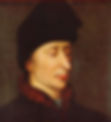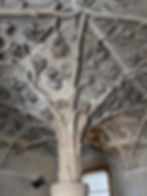A Tour of Jean Sans Peur's Toilet
- Kimberly Worsham
- Sep 11, 2021
- 5 min read
Updated: Jan 24, 2024
This is the oldest toilet in Paris!

FLUSH's Kim Worsham went to France for a holiday recently and found some French toilet history to share with you! The first toilet visit was the Tower of John the Fearless from the turn of the 15th century (in French, it's Tour Jean sans Peur, which we will be using in this blog). The tower is believed to house the oldest toilet in Paris currently! In this blog post, we'll share details about sanitation and hygiene in the Middle Ages, some history around when this toilet was functioning, and a tour of this cool, hidden history.
About Paris Buildings
How do we know that this is the oldest toilet in Paris? Well, officially, we don't, but we can guess that it likely is the only one from its era that remains today. What's remarkable about Paris is how very few medieval buildings still exist.
Though the city has been around for over 800 years, urbanization, war, and city fires have destroyed most buildings from the Middle Ages and before. What's left from the Middle Ages include the underground parts of the Louvre, the Bastille, the CLUNY, a couple of other buildings and houses, and….Tour Jean sans Peur.
Toilets in Medieval Paris
Toilets in the Middle Ages were not all that common. Most domestic toilets were for the nobility, as they were considered a luxury. Some more reputable houses had communal toilets attached to two houses and had a cesspit underneath. If you didn't have something inside, like almost everyone else, you had to defecate outside.

The Middle Ages weren't the cleanest time to be alive - the streets were filthy with mud and excrement. Bridges held public toilets, which had holes that directly released excrement into the rivers below. Some covered passages had public toilets dumped onto streets. Wells and cisterns had human waste and trash pollution. It was not pleasant, and by this time, the concept of miasma was popular (as we've recently explored).
There were a few kinds of toilets at the time:
Garderobes clung to the side of a house or tower, and waste fell into an alley, moat, or a duct space where the waste could be collected for compost in a pit annually.
Angled toilets only got cleaned out when it was raining, as the waste emptied into an outside duct.
Pit latrines had a duct that emptied waste directly into a pit in the ground.
From the 14th century, Paris started to legislate human waste. By 1374, King Charles the 5th mandated that all properties needed to have private toilets that led to a pit or an open sewer and not empty onto the streets. In the 14th century, Parisians paid a tax to clean up streets, too. Finally, Charles the 6th made it illegal to throw excrement into waterways, and pedestrians weren't allowed to urinate on buildings anymore. Despite these efforts, Paris was still rather gross.
Fun Tangential Fact: Almost ironically, medical experts at the time used urine and human excrement to examine someone's health. They'd observe and analyze waste color and taste (yes, you read that correctly) to determine the correct treatment for their patients. Also, sometimes people used excrement to treat different ailments, such as scrofula (i.e., when tuberculosis causes fistulas on the neck's lymph nodes).
Tower History
Tour Jean sans Peur is the former residence for the Duke of Burgundy (in French, Bourgogne) that ruled for about 15 years (1409-1419). Before the tower, in 1270, Robert of Artois bought the land, which was then part of the northern suburbs of Paris. In 1369, the Artois family merged with the Burgundies. The land became the property of the Burgundy dynasty for a little over a century. At the end of the 14th century, as Paris grew, the land became a part of the city.
You may remember from history class learning about the Hundred Years War. Still, if not, we have a very brief recap: In the 14th and 15th centuries, the French and English kings disputed the French crown and fought for ownership throughout the French countryside. At the same time, the dukes of Burgundy and Orleans (another powerful French house) were fighting for power against the King of England.

In 1404, Jean sans Peur became the Duke of Burgundy. He and the Duke of Orleans, Louis (aren't they all), fought to fill the power gap left by King Charles the 6th, who was likely mentally unwell. In 1407, Jean sans Peur had Louis d'Orleans assassinated, which split France into pro-Burgundy followers and those who wanted to avenge the murder of the Duke of Orleans.
After the murder, Jean sans Peur took his newly-held power and built a large staircase tower/watchtower to guard against angry pro-Orleans groups. Since Jean sans Peur's time, the tower changed owners, purposes, and had restorations.
This is the very tower that includes the toilets we're here for now.
Touring the Tower
When looking at Tour Jean sans Peur, it's clearly meant for looking down and surveying the land. The tower reaches about 90 feet (27 meters), and there are few windows except for one at the top. As you go up the spiral staircase inside, each floor has an outdoor space or a large room, and the stairwell gets darker. Yet, even in the darkness, the architecture of the stairwell is beautiful.

You have to climb up the stairs to the 6th or 7th floor to see the toilet action. Actually, there were two toilets in the tower - on the top two floors. For this tour, we focused on second-highest floor, where the principal latrine is that we believe to be the oldest lasting toilet in Paris.
Images of the entrance to the toilet, and the toilet (Credit: FLUSH/Kim Worsham)
The Jean sans Peur toilet was a pit latrine – it had evacuation ducts in the wall where waste dropped dramatically 90 feet into a pit in the basement. The toilet itself is in a private area, hidden by a long entryway and tucked into the side of the wall. There's also a window that lightens the mood in the room, maybe making bathroom use a bit brighter.
Images of the bathroom window and the washing basin (Credit: FLUSH/Kim Worsham)
It was a pretty sophisticated toilet for the time and had some comfortable amenities to it. The toilet was right behind a fireplace, making it heated and cozier in the cold winters. The wall hangings in the toilet now have the coat of arms for the Duke of Burgundy, envisioning what it may have been like all 700 years ago. The toilet seat would have also been covered in velvet, and the other side of the room would have had a washing basin.
How did they clean up after using the toilet? The nobility in this tower would have used cotton or linen towels. If they ran out, they might have also used leaves from the great mullein plant like everyone else would have (though peasants also would have used straw and mud).
A big thank you to the front desk at Tour Jean sans Peur for helping us get directions to the toilets, and for directing us to their booklets L’hygiène au Moyen Âge (2018) and La santé au Moyen Âge (2008), from which much of this blog's details came. Much of the other details about the tower and its history came from the museum's exhibit.







